
|

|
Life of the Civil War Soldier
Soldiers of the American Civil War
Life of the Civil War Soldier
The Civil War Soldier's Life
Introduction
The life of a soldier in the 1860s was an arduous one, and for the thousands
of young Americans who left home to fight for their cause, it was an experience none of them would ever forget. Military service
meant many months away from home and loved ones, long hours of drill, often inadequate food or shelter, disease, and many
days spent marching on hot, dusty roads or in a driving rainstorm burdened with everything a man needed to be a soldier as
well as baggage enough to make his life as comfortable as possible. There were long stretches of boredom in camp interspersed
with moments of sheer terror experienced on the battlefield. For these civilians turned soldiers, it was very difficult at
first getting used to the rigors and demands of army life. Most had been farmers all of their lives and were indifferent to
the need to obey orders. Discipline was first and foremost a difficult concept to understand, especially in the beginning
when the officer one had to salute may have been the hometown postmaster only a few weeks before. Uniforms issued in both
armies were not quite as fancy as those worn by the hometown militias, and soldiering did not always mean fighting. There
were fatigue duties such as assignments to gather wood for cook fires. Metal fittings had to be polished, horses groomed and
watered, fields had to be cleared for parades and drill, and there were water details for the cook house. Guard duty meant
long hours pacing up and down a well-trod line, day or night, rain or shine, always on watch for a foe who might be lurking
anywhere in the hostile countryside. A furlough was hard to come by as every man was needed in the field and few men ever
had a chance to visit home.
| Life of the Civil War Soldier |
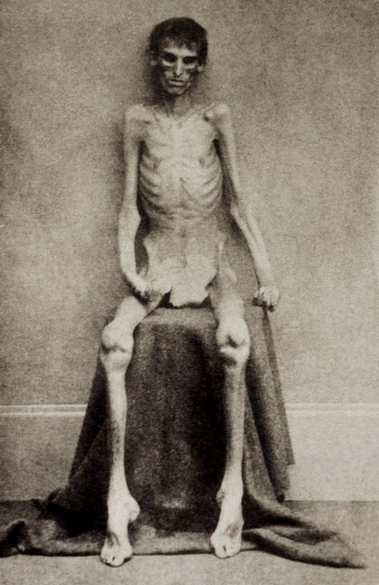
|
| Civil War POW Survivor |
Daily Routine
Imagine that you have joined the army as a private in the artillery during
the American Civil War (1861-1865). As a private in the Confederate army, you will be paid $132 a year, or $11 each month.
You will be paid $156 a year, or $13 each month, if you are a Union soldier. Your enlistment in the army will last for three
years. Shortly after enlisting you are sent to a place called the Camp of Instruction, meaning basic training or boot camp. The
Camp of Instruction will last several weeks. In the Camp, you will attend the School of the Soldier, which means instructors
will teach you how to stand at attention, salute, march, and perform many of the other duties of a soldier. As a soldier,
you are on duty 24 hours a day, 7 days a week. You day will generally be as follows:
5:00 a.m. A bugler will
sound "reveille" on a bugle. Everyone must get up, get dressed and prepare for morning roll call.
5:15 a.m. The
bugler sounds "assembly" and everyone falls in for roll call.
6:00 a.m. The next bugle call is "breakfast call."
7:00 a.m. "Fatigue call" is played telling the soldiers to prepare for inspection. You must make sure your musket, uniform,
bunk, and barracks are clean.
8:00 a.m. After inspection, the bugler plays "drill call." For the next
four hours, until noon, you will practice all the things you learned at the Camp of Instruction.
12:00 p.m.
"Dinner call" is sounded and you are allowed to eat your lunch.
1:00 p.m. "Drill call" is sounded again. Until
4:00 p.m. you drill, drill, and drill.
4:00 p.m. You will spend this time cleaning your equipment, barracks,
cannons, and the fort.
6:00 p.m. "Attention" is called to give you a few minutes to get ready for roll call.
Next, the bugler plays "assembly" and everyone falls in for dress parade roll call. This means everyone is in full uniform.
You are carrying your musket and wearing all your equipment.
7:00 p.m. The bugler now plays "assembly of the guard."
Those soldiers assigned to guarding the fort begin performing this duty. The remaining soldiers eat their evening meal and
relax.
8:30 p.m. "Attention" is played followed by "assembly." At this time roll call is taken and you are
dismissed.
9:00 p.m. "Tattoo" is sounded. This means everyone must go to bed. Your day is finally over.
| Life of the Civil War Soldier |

|
| Life of a Civil War Soldier |
Clothing and Accoutrements
Soldiers were generally issued a pair of wool pants with braces (suspenders),
a cotton shirt, a sack coat, a forage cap or kepi, a pair of brogans (shoes), wool socks, a wool greatcoat (overcoat), a belt
with belt buckle and cap pouch, a cartridge box for holding ammunition, a rifle, and bayonet.
Soldiers wore several
layers of clothing and had to carry everything with them. The first layer of clothing a soldier would wear would be his cotton
drawers (they do not have to wear these). Then the soldier would wear wool socks and a cotton shirt. The wool pants
go on next, with the suspenders (braces) over the soldier's shoulders. Next, the soldier would put on the brogans (shoes)
and sack coat. The cartridge box, with the sling would go over the left shoulder and the box resting on the right hip. The
belt goes over the cartridge box to hold everything in place. The cap pouch should be just in front of the cartridge
box. The soldier would then put on the forage cap. The haversack and canteen goes over the right shoulder and hangs on
the left side.
Braces: Suspenders were used instead of a belt to hold up a man’s
pants. Brogans: Leather shoes usually with heel plates to extend their wear.
Cap Pouch: Small pouch worn on belt. It held percussion caps for firing
the musket.
Cartridge: Small paper tube filled with gun powder and a lead bullet
(Minie Ball).
Cartridge Box: Leather pouch with attached sling, worn over the shoulder
that contained 40 rounds of ammunition (cartridges).
Drawers: Long, lightweight cotton (or flannel in winter) 19th Century
underwear. Forage Cap or Kepi: Dark blue wool uniform cap with leather brim.
Haversack: Tarred canvas bag that a soldier carried keepsakes from
home, personal belongs, and three days worth of food when on the march.
Food
A ration is the amount of food authorized for one soldier (or animal) for
one day. The Confederate government adopted the official US Army ration at the start of the war, although by the spring of
1862 they had the reduce it. According to army regulations for camp rations, a Union soldier was entitled to receive daily
12 oz of pork or bacon or 1 lb. 4 oz of fresh or salt beef; 1 lb. 6 oz of soft bread or flour, 1 lb. of hard bread, or 1 lb.
4 oz of cornmeal. Per every 100 rations there was issued 1 peck of beans or peas; 10 lb. of rice or hominy; 10 lb. of green
coffee, 8 lb. of roasted and ground coffee, or 1 lb. 8 oz of tea; 15 lb. of sugar; 1 lb. 4 oz of candles, 4 lb. of soap; 1
qt of molasses. In addition to or as substitutes for other items, desiccated vegetables, dried fruit, pickles, or pickled
cabbage might be issued. The marching ration consisted of 1 lb. of hard bread, 3/4 lb. of salt pork or 1 1/4 lb. of fresh
meat, plus the sugar, coffee, and salt. The ration lacked variety but in general the complaints about starvation by the older
soldiers was largely exaggerated.
Generally the Confederate ration, though smaller in quantity after the
spring of 1862 and tending to substitute cornmeal for wheat flour, was little different. But the Confederate commissary system
had problems keeping rations flowing to the troops at a steady rate, thus alternating between abundance and scarcity in its
issuances. Soldiers of both armies relied to a great extent on food sent from home and on the ever present Sutler.
| Life of the Civil War Soldier |
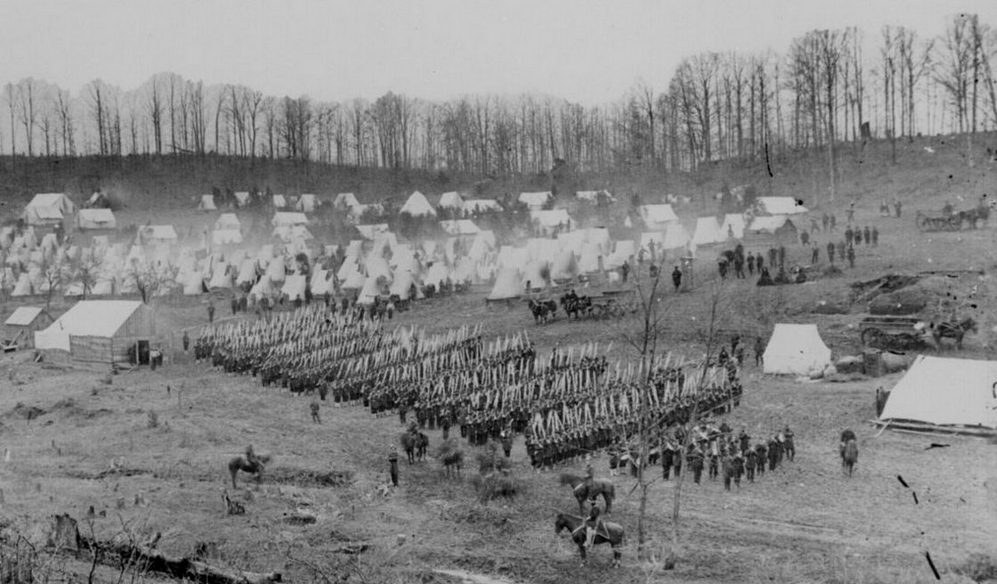
|
| Life of the Civil War Soldier in Camp |
Quarters
A soldier’s home in camp was a rectangular piece of canvas buttoned
to another to form a small two-man tent or dog tent as the soldiers called them. First introduced in 1862, every Union soldier
was issued one for use during active campaign and the men joked that only a dog could crawl under it and stay dry from the
rain. The tent could be easily pitched for the evening by tying each end to a rifle stuck in the ground by the bayonet or
by stringing it up to fence rails. Confederates did not receive shelter tents though some Confederate units were issued a
variation of the tent, which they pitched as a lean-to or shelter. As the war progressed it was very common for a Confederate
camp to be filled with captured Union tents as well as captured blankets, canteens, and haversacks. Confederates especially
prized the Union rubber blankets, which were not manufactured in the south and were ideal as a ground cloth or overhead shelter.
Army camps were like a huge bustling city of white canvas, sometimes obscured
by smoke from hundreds of campfires. Camps were considered temporary throughout the year until the winter months when the
armies would establish winter quarters. The soldiers would construct log huts that were large enough to accommodate several
men, made of trees taken from any nearby source. The logs were laid out on stones underneath the bottom log, in a rectangle
and notched to fit tight at the corners and stones, brick, or mud-covered logs were formed into a small fireplace in one end.
Mud filled the gap between the logs and inside of the chimney over the fireplace. A roof made from tents or sawn boards and
wooded bunks built inside finished the hut. Soldiers often named their winter huts after well known hotels or restaurants
back home such as “Wiltshire Hotel” or “Madigan’s Oyster House.” The armies quartered in these
small huts through the winter months and then it was back to the field and dog tents.
Drill and Discipline
The singular purpose of the soldier was to fight a battle and win. There
were a variety of small arms used during the Civil War. The average infantryman carried a muzzle-loading rifle-musket manufactured
in American arsenals or one purchased from foreign countries such as England. The bayonet was an important part of the rifle
and its steel presence on the muzzle of the weapon was very imposing. When not in battle, the bayonet was a handy candle holder
and useful in grinding coffee beans. The typical rifle-musket weighed eight and one-half pounds and fired a conical shaped
bullet called the Minie Ball. Bullets were made of very soft lead and caused horrible wounds which were difficult to heal.
The artillery was composed of both rifled and smoothbore cannon, each gun served by a crew of fourteen men including the drivers.
The role of the artillery was to support the infantry while the infantry role was to either attack or defend, depending on
the circumstances. Both branches worked together to coordinate their tactics on the field of battle. Cavalrymen were armed
with breech loading carbines, sabers, and pistols. Cavalry was initially used for scouting purposes and to guard supply trains.
The role of mounted troops had expanded by the time of Gettysburg, with cavalry divisions acting as skirmishers and fighting
mounted and on foot in pitched battles such as Brandy Station, Virginia on June 9, 1863. Other branches of the armies included
the signal corps, engineers, medical and hospital corps, as well as supply organizations including the quartermasters.
| Life of a Civil War Soldier |
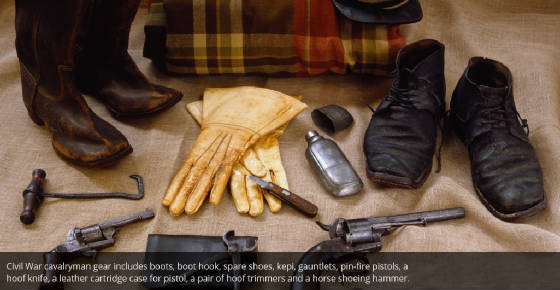
|
| Accoutrements of the Civil War Cavalry Soldier |
Marching and fighting drill was part of the daily routine for the Civil
War soldier. Infantry soldiers drilled as squads and in company formations, each man getting accustomed to orders and formations
such as marching in column and in a “company front,” how to face properly, dress the line, and interact with his
fellow soldiers. After an hour of drill on that level, the company moved onto regimental level drills and parades. The soldier
practiced guard mount and other procedures such as the Manual of Arms, which infantrymen learned for the rifle-musket. Veterans
of the war often remarked how they could recite the steps of loading and priming for many years after the war, thanks to the
continual drill.The drill was important for the infantry for they used tactics that had changed little since the time of the
American Revolution or the age of Napoleon: infantry fought in closely knit formations of two ranks (or rows) of soldiers,
each man in the rank standing side by side. This formation was first devised when the single-shot, muzzle loading musket became
the normal weapon on the battlefield, the close ranks being a necessity because of the limitations of the musket. Yet, by
1861, new technology had made the old fashioned smoothbore musket nearly obsolete with the introduction of the rifle musket.
By the time of the Gettysburg Campaign, the rifle musket made up the majority of infantry weapons in both the Union and Confederate
armies though it took much longer for the tactics to change. Even with the advance of the rifle musket, the weapons were still
muzzle loaders and officers believed that the old-fashioned drill formations were still useful to insure a massing of continuous
firepower that the individual soldier could not sustain. The result of this slow change was a much higher than anticipated
rate of casualties on the battlefield.
Cavalrymen drilled with their sabers, both on foot and horseback, while
artillerymen drilled with their cannons limbered up to the team of horses and unlimbered, ready to fire. Oddly enough, marksmanship
on a rifle range did not take precedence over other drill the soldiers learned for several reasons — the military believed
that each man would shoot accurately when told to and the war departments did not wish to waste ammunition fired on random
targets.
For the infantry, drums were used to announce daily activities, from sunrise
to sunset. Reveille was sounded to begin the day at 5 AM, followed by an assembly for morning roll call and breakfast call.
Sick call was sounded soon after breakfast, followed by assemblies for guard duty, drill, or to begin the march. Drummers
were also important on the march to keep soldiers in step during parades and to call them to attention. In battle, drums were
sometimes used to signal maneuvers and give signals for the ranks to load and fire their weapons. The artillery and cavalry
relied solely on buglers who were as important in their roles as the drummers were to the infantry. When not playing for their
respective regiments, musicians were often combined with regimental or brigade bands to play marching tunes or provide field
music for parades, inspections, and reviews.
Discipline in the military was very strict. The Provost Marshal of the army
was responsible for enforcing military rules, but regimental commanders also had the authority to dole out punishments for
minor offenses. Petty offenses such as shirking camp duty or not keeping equipment in good order were usually treated with
extra duties such as digging latrines, chopping wood, or standing extra hours on guard duty. Insubordination, thievery, cowardice,
or other offenses were more serious and the guilty party was usually subjected to embarrassing punishments such as carrying
a log, standing on a barrel, or wearing a placard announcing his crime. “Bucking and gagging” was also a common
punishment — the soldier’s limbs were bound and he was gagged so he could not speak. In the artillery, the guilty
person might be tied to the spare wheel on the back of a caisson. Desertion, spying, treachery, murder, or threats on an officer’s
life were the most serious offenses to which the perpetrator was condemned to military prison or shot by a firing squad. Crimes
committed against civilians were also punishable by the army and felons were executed by hanging before a formation of soldiers.
| Life of the Civil War Soldier |
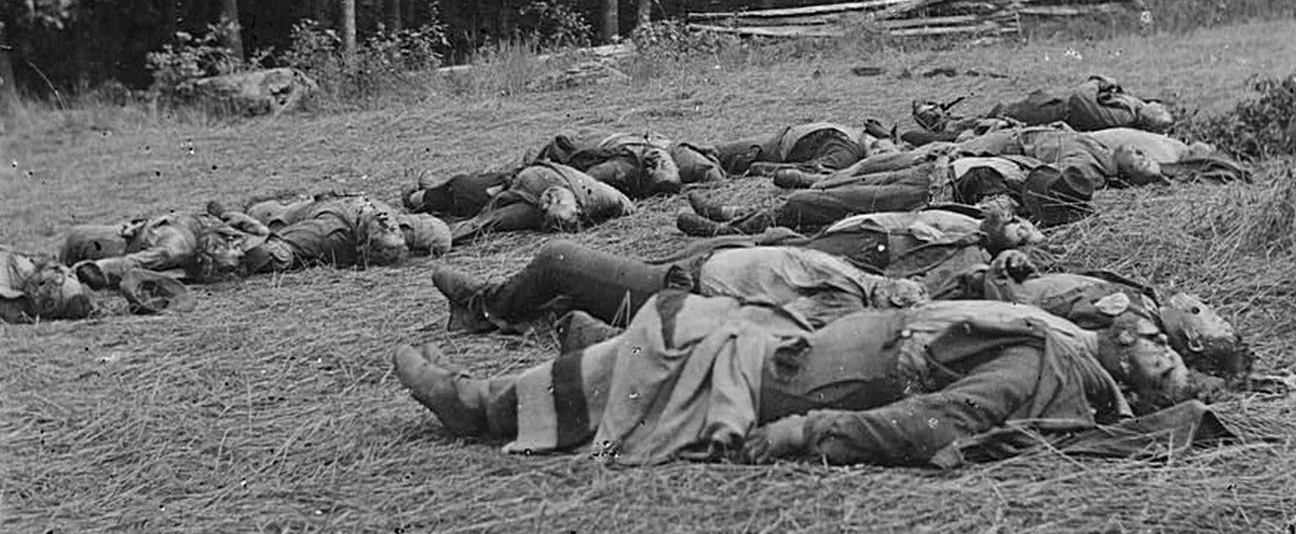
|
| Dead Soldiers on the Gettysburg Battlefield |
| Life of the Civil War Soldier |
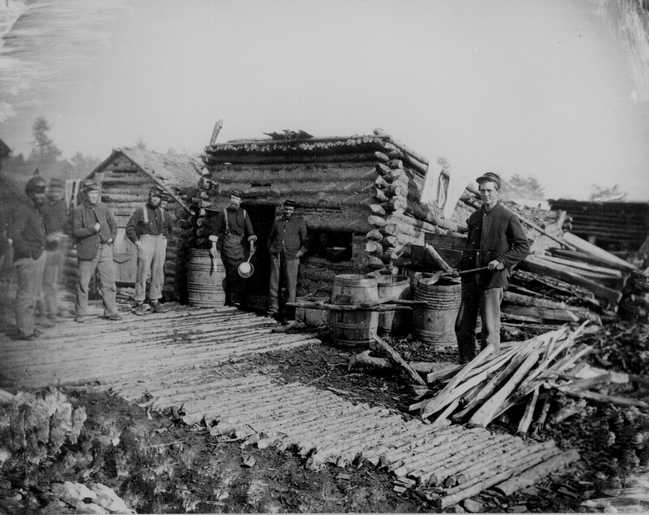
|
| The Camp Kitchen |
Camp Life
Leisure activities were similar in either army and most of it was spent
writing letters home. Soldiers were prolific letter writers and wrote at every opportunity. It was the only way for them to
communicate with loved ones and inform the home folks of their condition and where they were. Thrifty soldiers sent their
pay home to support their families and kept only a small amount to see them through until the next payday. The arrival of
mail in camp was a cause for celebration no matter where the soldiers were and there was sincere grumbling when the mail arrived
late. The lucky soldiers who received a letter from home often read and re-read them many times. Packages from home contained
baked goods, new socks or shirts, underwear, and often soap, towels, combs, and toothbrushes. Union soldiers often spent their
free time at the sutler’s store, comparable to the modern post exchange, where they could purchase toiletries, canned
fruit, pocketknives, and other supplementary items, but usually at exorbitant prices. A private’s salary amounted to
$13.00 per month in 1863 and those unfortunates who owed the sutler watched as most of their pay was handed over to the greedy
businessman on pay day. Confederates did not have the luxury of sutlers, who disappeared soon after the war began. Instead
they depended on the generosity of folks at home or farmers and businessmen near the camps.
Free time was also spent in card games, reading, pitching horseshoes, or
team sports such as the fledgling sport of baseball, a game which rapidly gained favor among Northern troops. Rule booklets
were widely distributed and the game soon became a favorite. Soldiers also played a form of football that appeared more like
a huge brawl than the game we know today, and often resulted in broken noses and fractured limbs. Holidays were celebrated
in camp with feasts, foot races, horse racing, music, boxing matches, and other contests. But while on active campaign, the
soldiers were limited to writing, cleaning uniforms and equipment, and sleeping.
Despite orders to the contrary, many soldiers kept pets with them including
dogs, cats, squirrels, raccoons, and other wildlife. One regiment from Wisconsin even had a pet eagle that was carried on
its own perch next to the regimental flags. General Lee was purported to have had a pet chicken that faithfully delivered
a fresh egg for the general everyday. By far the most popular pets appears to have been dogs and their presence with a master
in camp or on the march was often overlooked by high commanders. Many officers, including General George Armstrong Custer
who kept a number of dogs around his headquarters, favored the hardiness of these loyal companions and their companionship
was, as one soldier put it, a “soothing connection” with home. Both the 11th Pennsylvania Infantry and the 1st
Maryland Infantry (CSA) had singular dogs that followed the men through the most difficult campaigns including Gettysburg.
Sallie, the 11th Pennsylvania’s unofficial mascot, is remembered in a bronze likeness on the regimental monument at
Gettysburg and symoblized there for its loyalty to the dead of the regiment. The canine that accompanied the 1st Maryland
was regrettably killed in action on July 3 at Culp’s Hill, after having participated in the charge of the regiment.
Struck by the animal’s gallantry and loyalty to its human companions, a Union officer ordered that the animal be given
a proper burial alongside the dead of 1st Maryland.
Religion was very important in the soldier’s daily routine. Many of
the men attended church services on a regular basis and some even carried small testaments with the rest of their baggage.
Union and Confederate armies had numerous regimental and brigade chaplains. These loyal officers also acted as assistants
in field hospitals comforting the sick and wounded, and writing letters home for those who could not write. Chaplains held
field services for their respective units and most accompanied the soldiers as they marched onto the battlefield. Father William
Corby, the chaplain of the Irish Brigade, is best remembered for his granting of unconditional absolution to the members of
the brigade before they marched into battle in the Wheatfield on July 2nd. Father Corby was immensely popular with the men
and in the post-war era became president of Notre Dame University.
| Life of a Civil War Soldier |
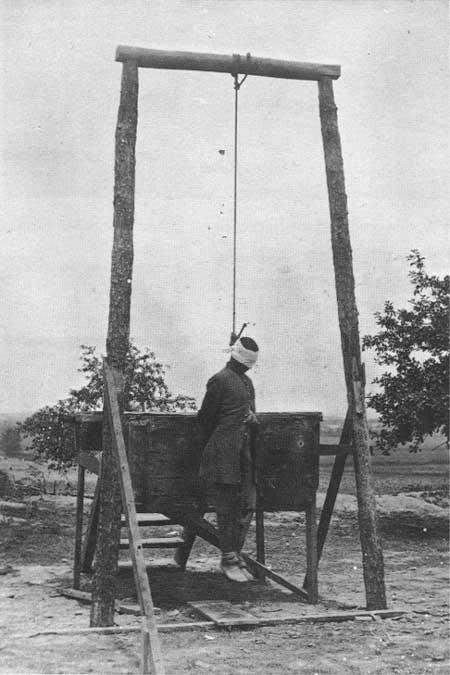
|
| Civil War Soldier Hanged |
| Life of the Civil War Soldier |
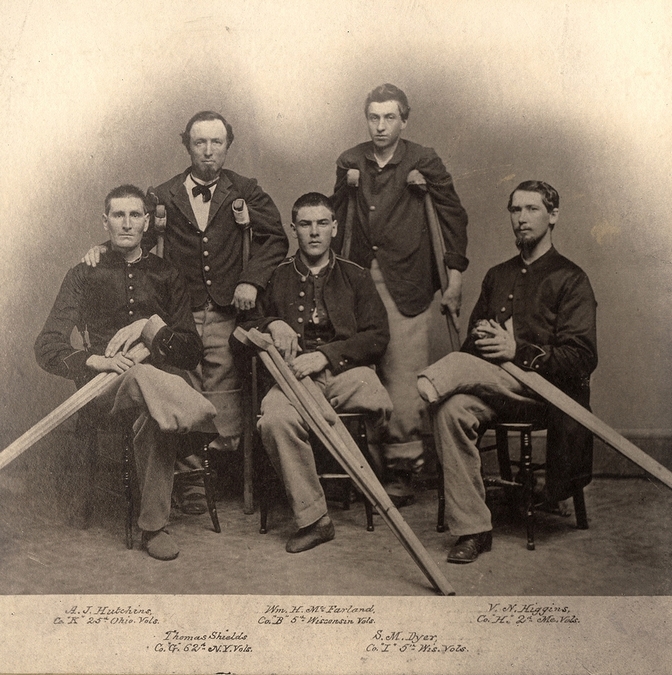
|
| Civil War Amputees |
(Left) Group of Civil War amputees. There were more amputations performed
during the Civil War than all other surgeries combined. Soldiers sometimes had their limbs cut off without any anesthesia,
which was a terrifying thought for many soldiers who were marching into battle. "Greater
level of amputation meant greater chance of mortality." The necessary removal of limb during the conflict was overwhelmingly
caused by the Miniť ball, a conical shaped bullet that would shatter bone on impact. Unlike the popular round ball of
the smoothbore musket, the Miniť ball had a higher muzzle velocity and greater weight. Round balls tended to remain lodged
in the flesh, and they were often observed to take a winding path through the body. Flexed muscles and tendons, as well as
bone, could cause the round ball to deviate from a straight path. The Miniť ball tended to cut a straight path and usually
went all the way through the injured part, while the ball seldom remained lodged in the body. If a Miniť ball struck a bone,
it usually caused the bone to shatter. The damage to bones was usually severe enough to necessitate amputation. Below the knee amputation meant 33% mortality, while more than half, 54.2%, of those
who had above the knee amputation would die. Crude medical procedures
and practices performed on soldiers during the Civil War would cause many amputees to die of disease,
namely gangrene. For example, without cleaning and sterilizing instruments between surgeries, surgeons would perform an amputation,
then wipe the surgical blade on the bottom of their boots to free it of bone, blood, and flesh, and then continue to perform
several, sometimes hundreds, of additional amputations. Photo courtesy National Archives. (Right) "African-American Hanged For
Mutiny By Union Army." While black soldiers comprised 10% of the entire U.S. Army during the Civil War, 80% of all soldiers
hanged by the Federal government were black. Their execution was generally a result of mutiny or desertion, but
the death sentence also included from allegations of rape to sleeping while on guard duty. Photo courtesy LOC.
Conclusion
Over the course of the Civil War, approximately three million men (and a
handful of women disguised as men) served in the armed forces. By comparison, before the war, the U.S. Army consisted of only
about 16,000 soldiers. The mobilization that took place over the four years of the war touched almost every extended family
North and South and affected the far reaches of the country that had split in two. By war’s end, approximately 620,000
men had died, an estimate that is currently undergoing scrutiny as historians question whether it is too low. Nevertheless,
this figure translates to a rate of death six times that experienced by Americans during World War II. The horrific,
and largely unanticipated, number of casualties suffered by Northern and Southern soldiers during the Civil War devastated
people throughout the country and influenced public life for years to come.
Most Civil War soldiers volunteered to fight, although some signed on as
conscripts (the Confederacy began to draft men in April 1862; the Union in March 1863). North and South, men joined companies
formed in their communities. Within their companies, they served beside relatives, friends, and neighbors. Within their regiments,
which were formed from ten companies, soldiers served with men from their state. Despite these ties, desertion was an ongoing
problem for both sides (about 200,000 Union men and about 100,000 Confederates abandoned their posts), though it had a greater
effect on the smaller Confederate army. On both sides during the Civil War, most soldiers were unmarried white men who had
been born in the United States. Their average age was twenty-five. Most could read and write and attended a Protestant
church. The majority were farmers. In both sections of the country, wealthy men had the option of hiring a substitute
if drafted and, in the South, men who owned twenty or more slaves were exempted from service so they could remain on their
plantations, although just a small percentage of qualified slaveowners took advantage of this provision. These policies
that favored the rich caused resentment within the ranks, both North and South.
There were also some differences between the Union and Confederate armies. The
Union army was more ethnically diverse; recent immigrants from Ireland and Germany formed Union regiments, as did some 180,000
African American men who joined beginning in 1863. Men enlisted for a variety of reasons, including friendship and peer
pressure, as well as the desire for excitement and adventure. In addition, men joined up for ideological reasons. Among both
Confederate and Union soldiers were men who fought to protect their liberty and preserve the right to selfgovernment that
their ancestors had gained in the Revolutionary War. For Union men and boys, protecting their liberty meant preserving
the Union. At the beginning of the war, most Union soldiers did not fight to abolish slavery, but that was certainly
a goal for the African American men given the opportunity to enlist by
President Abraham Lincoln’s Emancipation Proclamation. For Confederate soldiers, protecting their liberty meant defending
their home soil and asserting their rights as residents of their states. Although most Confederate soldiers did not own slaves,
many of them included the right to own slaves among the states’ rights that they fought to maintain.
Before soldiers departed for training camps with their companies, they often
had a formal send-off attended by their families and local officials. Female relatives frequently presented companies with
hand-sewn flags to carry into battle. In 1861, most men and their relatives believed that the volunteers would only be away
for a short time before the war ended. After they arrived at their camps of instruction, the newly minted soldiers soon found
more monotony than excitement. New recruits had to learn more than ninety commands. Most soldiers found drilling
dull and onerous. In addition to drilling, other duties included taking care of livestock, serving on picket (guard)
duty, and gathering and cutting wood. If they wanted to leave camp, soldiers had to get a pass; this rankled many of the men,
who were used to being independent. Of course, camp life was not all work. During their usually plentiful free time, soldiers
sang, played sports such as baseball and games such as dominoes, wrote letters home, and attended church services and revivals.
They also indulged in less wholesome pastimes, such as gambling, drinking, and taking up with prostitutes. Soldiers also
used their free time to forage for food to supplement their diets.
| Life of a Civil War Soldier |
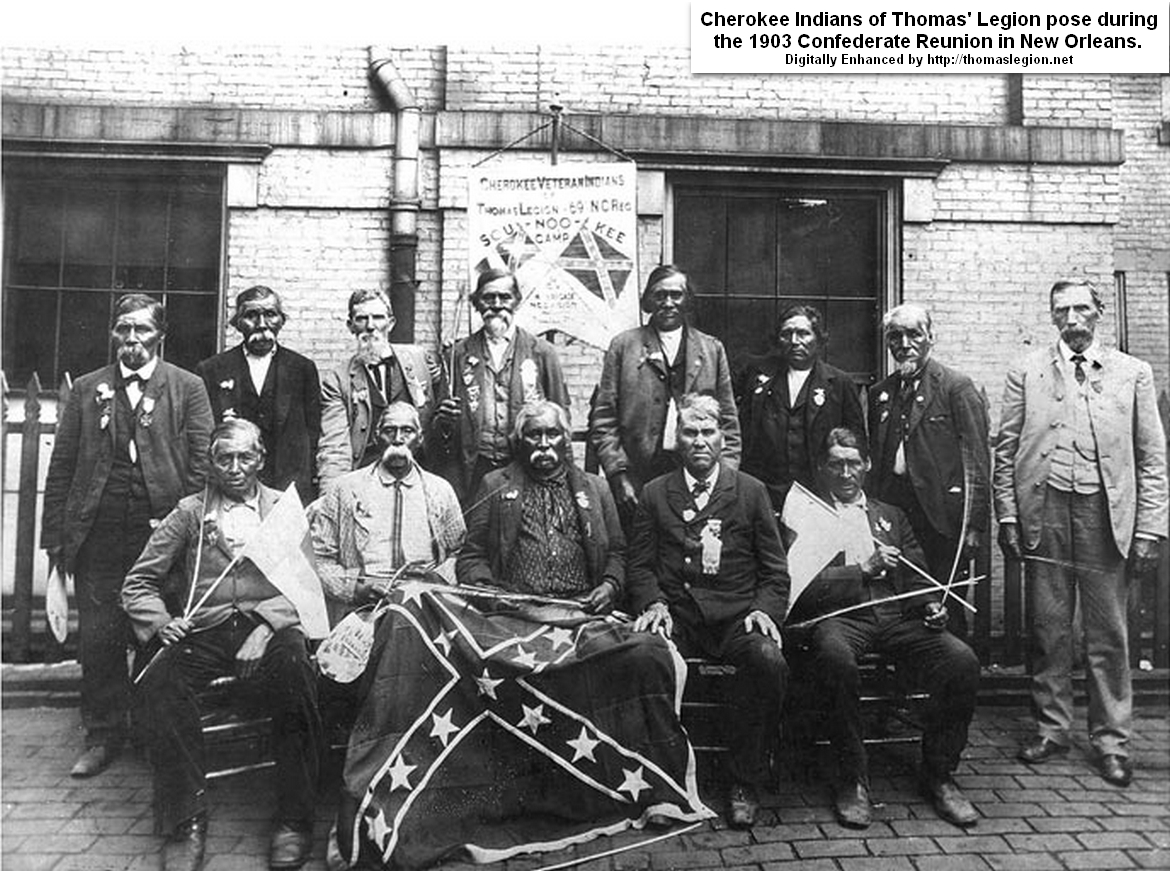
|
| Civil War Soldiers at the Last Confederate Reunion in New Orleans |
Camp food was not appealing. Northern soldiers received bacon, hardtack
(heavy crackers), and coffee; Southern soldiers relied on pickled beef and cornbread. Confederate soldiers found their standard
ration reduced twice over the course of the war due to the failure of the Confederacy’s supply lines after Union incursions
into the region. Staying healthy was by far the greatest challenge of camp life. Poor sanitation and poor diets combined
to create unhealthy environments. Within the close quarters of camp, diseases became rampant. Epidemics of mumps, measles,
and chicken pox raced through Civil War training camps. Deadly diseases such as dysentery, malaria, and typhoid fever took
a heavy toll. Before their men had even set foot on the battlefield, many companies had lost as many as one-third to
disease. Throughout the Civil War, disease claimed more lives than combat.
Camps became very busy before battles, most of which took place in the heat
of summer. Extra rations were prepared, and ammunition was distributed (each soldier typically received 40-60 rounds—a
round was made up of a bullet and the powder needed to fire it). Most soldiers carried rifled muskets or, increasingly, rifles,
both of which had far better range and accuracy than the basic musket used in previous wars
on American soil. Before trekking into battle, soldiers were inspected by their officers and urged to stay calm and aim
low. As they marched to meet the enemy, soldiers faced several challenges, including forced marches and making their way along
poor roads that were either muddy or dusty, painful feet from shoes or boots that did not fit right, bloodied and frostbit
feet for those absent any footwear, discomfort from the heavy loads they carried (many men ditched provisions along
the way only later to regret it), and the constant threat of sunstroke or frostbite. “Overwhelming” best
describes the experience of battle for Civil War soldiers. Many men could not—or would not—go into details
about the fighting afterward with their families or other civilians. The noise and smoke of battle overpowered soldiers’
senses. Amidst the smoke, trees, and other vegetation (most battles were fought in or near forests), men could barely
see. At the same time, they were besieged by loud and disturbing noises, including the boom of artillery, the whirring of
bullets, the beating of drums, the Rebel yell, and the screams of the wounded. Trained to fight, soldiers, though untrained
to ignore the injured and dying men around them, had to continue and advance, but this was difficult even for veteran
soldiers.
After a battle, most soldiers were physically exhausted and emotionally
distraught. Survivors from the winning side usually buried the dead with the help of local residents. Wounded soldiers suffered
considerably. Although military doctors and administrators made progress over the course of the war in the areas of sanitation
and organization, medical care remained rudimentary in the mid-nineteenth century. The germ theory was unknown; there
were no blood transfusions; and antibiotics had not yet been invented. What is more, there were never enough doctors to care
for the wounded, especially in the Confederacy. To prevent infection and gangrene (the death of body tissue that can
set in after infection), doctors tried to amputate wounded legs or arms within twenty-four hours. Patients often underwent
amputations without any anesthesia. Soldiers with wounds to the torso had less chance to survive than did men with bloody
limbs. Both wounded and unwounded soldiers sometimes found themselves taken as prisoners of war during battles.
Nearly 400,000 soldiers, or approximately 200,000 soldiers from each side, became
prisoners over the course of the war. Both Northern and Southern prisoners did not fare well during incarceration, and
exposure to unsanitary conditions and terrible food accelerated their demise. In addition,
overcrowding in military prisons became a real problem when there was a suspension of prisoner exchanges from mid-1863 to
late in 1864, prompted in part, by the Confederate government’s declaration that it would not treat black Union
soldiers or their officers as prisoners of war but as property or criminals, respectively. The North was also to blame, for
Union officials refused to exchange prisoners, stating that skeletons in their ranks didn't make for good soldiers.
When the war concluded and military service was over, most men had undergone
life-changing experiences. Most of them sought, however, to get on with their lives, reuniting with their families, returning
to the land to farm, or seeking other occupations. North and South, many former soldiers eventually became involved with
veterans’ organizations. But it would take years for the nation to heal.
Sources: National Archives; Library of Congress; Official Records of the
Union and Confederate Armies; US National Library of Medicine; University of North Carolina at Chapel Hill; Boatner, Mark
M., The Civil War Dictionary: Revised Edition. New York: Vintage Books, 1991. ISBN 0-679-73392-2; Faust, Patricia L.,
ed., The Historical Times Encyclopedia of the Civil War. Harper Collins, 1986. ISBN 0-06-181261-7; Hagerman, Edward. The American
Civil War and the Origins of Modern Warfare: Ideas, Organization, and Field Command (1992).
|

|

|

